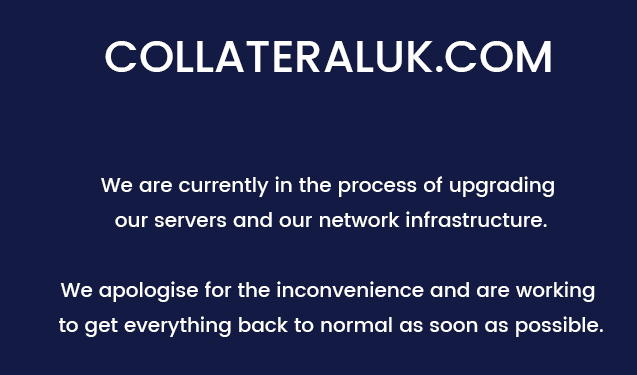Update Feb 28th, 10:50pm: according to a message recieved by affected investors, Collateral (UK) Ltd is going into administration
Or rather, why is Collateral down? A question concerned investors have been speculating on for over 36 hours now, since the website of UK p2p lending platform Collateral went down around 7pm two days ago and is showing a maintenance message. Investors criticize that there was no pre-announcement of this maintenance and worse that Collateral seemed to have ceased all communications to investors and did not react to any phone or email messages.
With no communications from the platform whatsoever investors wondered what to do. Some investors reported the incident to ActionFraud squad of the police while another contacted the FCA to voice his concern and seek advice.
This morning Collateral sent out this email to investors: ‘An update is being prepared and will be emailed to all lenders later today. Thanks for your patience, The Collateral Team‘.
So while at the time of writing of this article it is unclear what’s up at Collateral, this event does present two general questions in my view:
1) How should a p2p lending platform communicate in a crisis?
In my view not communicating at all is the worst choice. As investors pointed out, even if the nature of the crisis prevented communication through own website or email, then the platform could have elected to leave a message via the Twitter or Facebook channel. While that would have not reached all investors, it would have been better than silence.
2) What can concerned investors actually do to react, if the platform is seemingly unreachable/unresponding over a longer period of time?
The discussions amongst investors show great frustration on this point. And the questions is, how helpful any of the discussed measures really would be. The main suggestions were trying alternative phone contacts (calling management directly), visiting office in person, reporting to authorities (police, FCA), alerting the press.
From this incident I would say there is little investors can do to force an immediate reaction.
Regardless what was happening and what the outcome will be, my opinion is that this will tarnish the reputation of Collateral and that investors might try to withdraw (part) of their funds, once the platform is operational again.


 P2P lending marketplace
P2P lending marketplace 